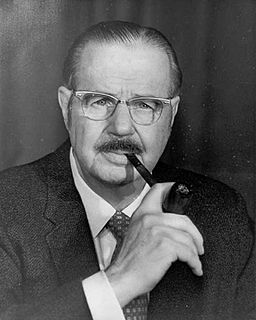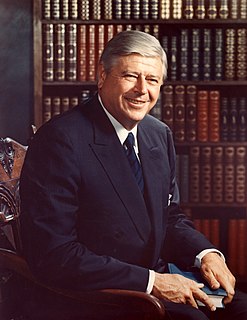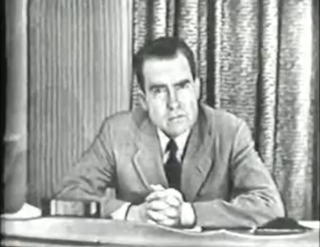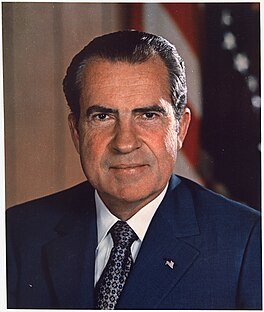
The 1952 United States presidential election was the 42nd quadrennial presidential election. It was held on Tuesday, November 4, 1952. Republican Dwight D. Eisenhower won a landslide victory over Democrat Adlai Stevenson, ending a string of Democratic Party wins that stretched back to 1932.

The Republican National Committee (RNC) is a U.S. political committee that provides national leadership for the Republican Party of the United States. It is responsible for developing and promoting the Republican political platform, as well as coordinating fundraising and election strategy. It is also responsible for organizing and running the Republican National Convention. Similar committees exist in every U.S. state and most U.S. counties, although in some states party organization is structured by congressional district, allied campaign organizations being governed by a national committee. Ronna Romney McDaniel is the current committee chairwoman.
The Republican National Convention (RNC) is a series of presidential nominating conventions of the United States Republican Party since 1856. Administered by the Republican National Committee, the stated purpose of the convocation is to nominate an official candidate in an upcoming U.S. presidential election, and to adopt the party platform and rules for the election cycle.

Llewelyn Sherman Adams was an American politician, best known as White House Chief of Staff for President Dwight D. Eisenhower, the culmination of an 18-year political career that also included a stint as Governor of New Hampshire. He lost his White House position in a scandal when he accepted an expensive vicuña coat.

Hugh Doggett Scott Jr. was an American lawyer and politician. A member of the Republican Party, he represented Pennsylvania in the United States House of Representatives and the United States Senate. He served as Senate Minority Leader from 1969 to 1977.

Rogers Clark Ballard Morton was an American politician who served as the U.S. Secretary of the Interior and Secretary of Commerce during the administrations of Presidents Richard M. Nixon and Gerald R. Ford, Jr., respectively. He also served as a member of the U.S. House of Representatives from Maryland.

The Checkers speech or Fund speech was an address made on September 23, 1952, by the Republican candidate for Vice President of the United States, California Senator Richard Nixon. Nixon had been accused of improprieties relating to a fund established by his backers to reimburse him for his political expenses. With his place on the Republican ticket in doubt, he flew to Los Angeles and delivered a half-hour television address in which he defended himself, attacked his opponents, and urged the audience to contact the Republican National Committee (RNC) to tell it whether he should remain on the ticket. During the speech, he stated that regardless of what anyone said, he intended to keep one gift: a black-and-white dog who had been named Checkers by the Nixon children, thus giving the address its popular name.

The 1952 Republican National Convention was held at the International Amphitheatre in Chicago, Cook County, Illinois from July 7 to July 11, 1952, and nominated the popular general and war hero Dwight D. Eisenhower of Kansas, nicknamed "Ike," for president and the anti-communist crusading Senator from California, Richard M. Nixon, for vice president.
The 1964 National Convention of the Republican Party of the United States took place in the Cow Palace, Daly City, California, on July 13 to July 16, 1964. Before 1964, there had been only one national Republican convention on the West Coast, the 1956 Republican National Convention, which also took place in the Cow Palace. Many believed that a convention at San Francisco indicated the rising power of the Republican party in the west.

The 1968 National Convention of the Republican Party of the United States was held at the Miami Beach Convention Center in Miami Beach, Dade County, Florida, from August 5 to August 8, 1968, to select the party's nominee in the general election. It nominated former Vice President Richard M. Nixon for President and Maryland Governor Spiro T. Agnew for Vice President. It was the fourth time Nixon had been nominated on the Republican ticket as either its vice-presidential or presidential candidate (1960).
Guy George Gabrielson was a Republican politician from New Jersey. He served as chairman of the Republican National Committee from 1949 to 1952, and was a member of the New Jersey General Assembly from 1925 to 1929, and was its Speaker in 1929.

The 1956 Republican National Convention was held by the Republican Party of the United States at the Cow Palace in San Francisco, California, from August 20 to August 23, 1956. U.S. Senator William F. Knowland was temporary chairman and former speaker of the House Joseph W. Martin Jr. served as permanent chairman. It renominated President Dwight D. Eisenhower and Vice President Richard M. Nixon as the party's candidates for the 1956 presidential election.

The 1952 Republican presidential primaries were the selection process by which voters of the Republican Party chose its nominee for President of the United States in the 1952 U.S. presidential election. Former U.S. Army General Dwight D. Eisenhower was selected as the nominee through a series of primary elections and caucuses culminating in the 1952 Republican National Convention held from July 7 to July 11, 1952, in Chicago, Illinois.
Thomas J. Josefiak is an American lawyer who was Chief Counsel of Republican National Committee (RNC) and Chairman of the Federal Election Commission (FEC) during the 1988 U.S. presidential election. Josefiak is currently a partner with the law firm of HoltzmanVogelJosefiak PLLC in Washington, D.C..
Stephen H. Hess is a senior fellow emeritus in the Governance Studies program at the Brookings Institution. He studies media, the U.S. presidency, political dynasties and the U.S. government. He first joined Brookings in 1972 and was distinguished research professor of media and public affairs at the George Washington University (2004–2009). He served on Presidents Dwight D. Eisenhower and Richard Nixon's White House staff and as an adviser to Presidents Gerald R. Ford and Jimmy Carter.
Clyde A. Wheeler was an American congressional relations expert, lobbyist, and member of the White House staff. After leaving the White House staff, he returned to Oklahoma, where he settled in Tulsa and became a lobbyist for Sun Oil Company. He retired from Sun in 1984 and returned to his ranch in his home town of Laverne, Oklahoma. He continued to do part-time work as a consultant for two Washington law firms until 1988. He died in Laverne in 2013.

Reinhold Richard "Reince" Priebus is an American lawyer and politician who served as White House Chief of Staff for President Donald Trump from January 20, 2017, until July 31, 2017. He also served as the chairman of the Republican National Committee (RNC) from 2011 to 2017.
"As Maine goes, so goes the nation" is a phrase that at one time was in wide currency in United States politics. The phrase described Maine's reputation as a bellwether state for presidential elections. Specifically, Maine's September election of a governor predicted the party outcome of the November presidential election in 19 out of the 26 presidential election years from 1832 to 1932, or 73 percent of the time. The accurate years were from 1832 through 1844, in 1852, from 1860 through 1876, in 1888, from 1896 through 1908 and from 1920 through 1932.

The 1972 United States presidential election in Texas was held on November 7, 1972. Incumbent Republican President Richard Nixon overwhelmingly won the state of Texas with 66.20 percent of the vote, to the Democratic Party candidate George McGovern’s 33.24 percent, thus giving him the state’s 26 electoral votes. This was the first time a Republican won the state of Texas since 1956.

Katherine Marie Walsh is an American Republican political operative who briefly served as White House Deputy Chief of Staff for Implementation in the administration of U.S. President Donald Trump. She is currently working with the Trump-aligned 501(c)(4) America First Policies.




















